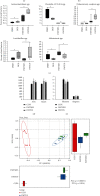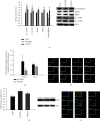Microbiota from Exercise Mice Counteracts High-Fat High-Cholesterol Diet-Induced Cognitive Impairment in C57BL/6 Mice
- PMID: 36713033
- PMCID: PMC9883105
- DOI: 10.1155/2023/2766250
Microbiota from Exercise Mice Counteracts High-Fat High-Cholesterol Diet-Induced Cognitive Impairment in C57BL/6 Mice
Abstract
Gut microbes may be the critical mediators for the cognitive enhancing effects of exercise. Via fecal microbiota transplantation (FMT), this study is aimed at determining the mechanism of how voluntary exercise improved learning and memory ability impairment post a high-fat, high-cholesterol (HFHC) diet. The learning and memory abilities assessed via the Morris water maze in the FMT recipient group of voluntary exercising mice were improved compared to sedentary group. 16S rRNA gene sequencing results indicated that exercise-induced changes in gut microbiota distribution were transmissible, mainly in terms of elevated Lactobacillus, Lactobacillus, and Eubacterium nodatum, as well as decreased Clostrida_UCG-014 and Akkermansia after FMT. The neuroprotective effects of FMT were mainly related to the improved insulin signaling pathway (IRS2/PI3K/AKT) and mitochondrial function; inhibition of AQP4; decreased p-Tau at serine 396 and 404; increased BDNF, PSD95, and synaptophysin in the hippocampus; and also decreased HDAC2 and HDAC3 protein expressions in the nuclear and cytoplasmic fractions of the hippocampus. The findings of qRT-PCR suggested that exercise-induced gut microbes, on the one hand, elevated GPR109A and decreased GPR43 and TNF-α in the hippocampus. On the other hand, it increased GPR109A and GPR41 expressions in the proximal colon tissue. In addition, total short-chain fatty acid (SCFA), acetic acid, propionic acid, isobutyric acid, valeric acid, and isovaleric acid contents were also elevated in the cecum. In conclusion, exercise-induced alterations in gut microbiota play a decisive role in ameliorating HFHC diet-induced cognitive deficits. FMT treatment may be a new considerable direction in ameliorating cognitive impairment induced by exposure to HFHC diet.
Copyright © 2023 Rui Li et al.
Conflict of interest statement
The authors declare no conflicts of interest.
Figures





Similar articles
-
Reshaping the gut microbiota: Tangliping decoction and its core blood-absorbed component quercetin improve diabetic cognitive impairment.Phytomedicine. 2025 May;140:156560. doi: 10.1016/j.phymed.2025.156560. Epub 2025 Mar 5. Phytomedicine. 2025. PMID: 40058319
-
Fecal microbiota transplantation confers beneficial metabolic effects of diet and exercise on diet-induced obese mice.Sci Rep. 2018 Oct 23;8(1):15625. doi: 10.1038/s41598-018-33893-y. Sci Rep. 2018. PMID: 30353027 Free PMC article.
-
Platycodon grandiflorus root extract activates hepatic PI3K/PIP3/Akt insulin signaling by enriching gut Akkermansia muciniphila in high fat diet fed mice.Phytomedicine. 2023 Jan;109:154595. doi: 10.1016/j.phymed.2022.154595. Epub 2022 Dec 10. Phytomedicine. 2023. PMID: 36610135
-
The relationship between gut microbiota and susceptibility to type 2 diabetes mellitus in rats.Chin Med. 2023 May 5;18(1):49. doi: 10.1186/s13020-023-00717-9. Chin Med. 2023. PMID: 37147692 Free PMC article.
-
Fecal microbiota transplantation and short-chain fatty acids improve learning and memory in fluorosis mice by BDNF-PI3K/AKT pathway.Chem Biol Interact. 2023 Oct 27:110786. doi: 10.1016/j.cbi.2023.110786. Online ahead of print. Chem Biol Interact. 2023. PMID: 39491142
Cited by
-
Aerobic exercise alleviates cognitive impairment in T2DM mice through gut microbiota.Sci Rep. 2025 Jul 4;15(1):23917. doi: 10.1038/s41598-025-07220-1. Sci Rep. 2025. PMID: 40615512 Free PMC article.
-
The role of gut microorganisms and metabolites in intracerebral hemorrhagic stroke: a comprehensive review.Front Neurosci. 2024 Feb 21;18:1346184. doi: 10.3389/fnins.2024.1346184. eCollection 2024. Front Neurosci. 2024. PMID: 38449739 Free PMC article. Review.
-
A preliminary study on the changes of fecal short chain fatty acids in patients with traumatic spinal cord injury in the chronic phase.Spinal Cord Ser Cases. 2025 Feb 25;11(1):3. doi: 10.1038/s41394-025-00698-x. Spinal Cord Ser Cases. 2025. PMID: 40000601
-
Research development on gut microbiota and vulnerable atherosclerotic plaque.Heliyon. 2024 Feb 8;10(4):e25186. doi: 10.1016/j.heliyon.2024.e25186. eCollection 2024 Feb 29. Heliyon. 2024. PMID: 38384514 Free PMC article. Review.
-
Major Depressive Disorder and Gut Microbiota: Role of Physical Exercise.Int J Mol Sci. 2023 Nov 28;24(23):16870. doi: 10.3390/ijms242316870. Int J Mol Sci. 2023. PMID: 38069198 Free PMC article. Review.
References
MeSH terms
Substances
LinkOut - more resources
Full Text Sources

